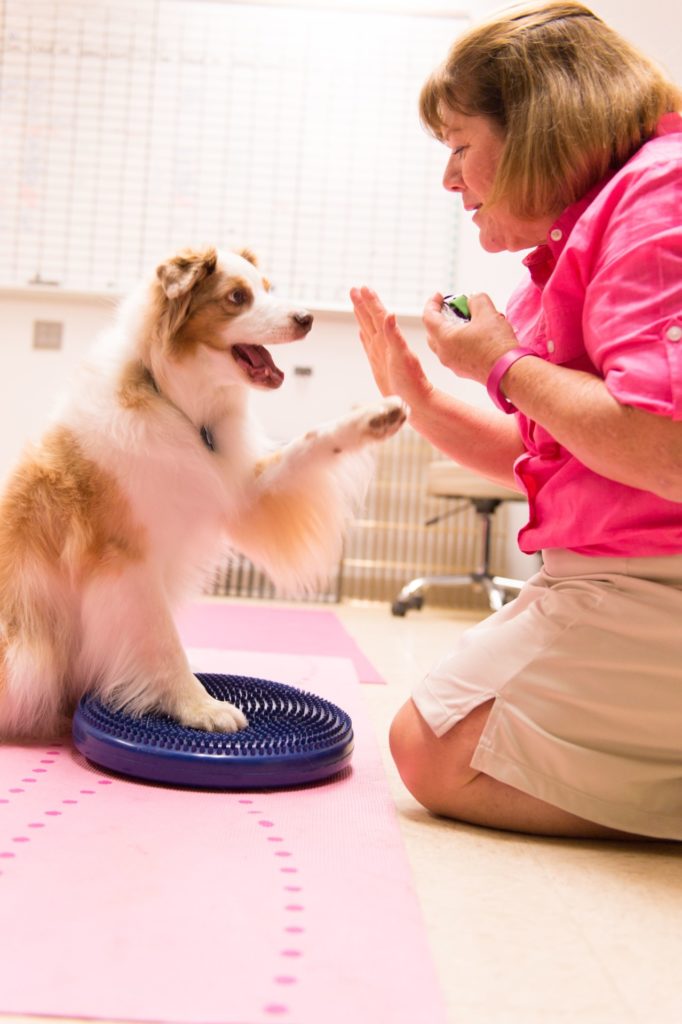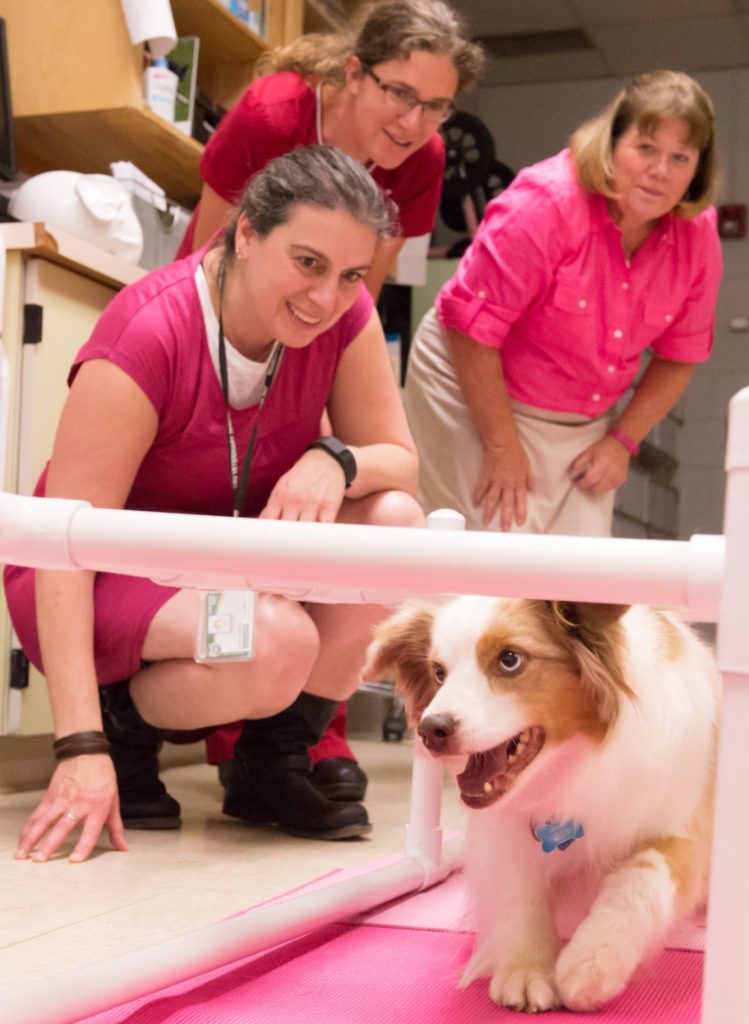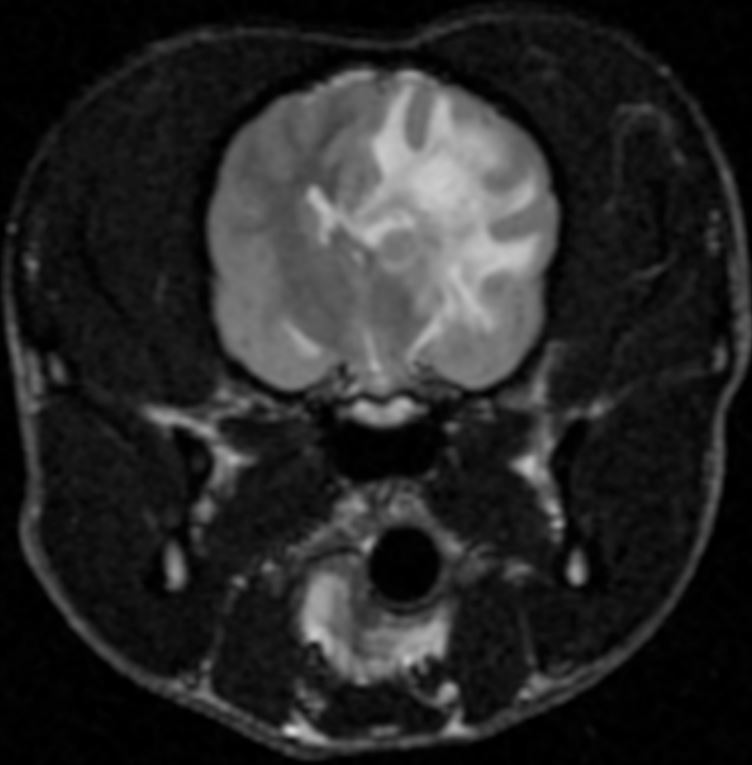In the span of a week, a lively miniature Australian shepherd named Cricket Hope went from dashing through flyball courses to lying nearly comatose on a bed. Her owners didn’t know it then, but a mass was growing in her brain.
“One day she tripped. Then she vomited and cried. We thought she had a stomach ache or something,” Cricket’s owner, Chari Leleck, said.
Cricket’s condition quickly worsened – she had a grand mal seizure – and specialists at the Parker Animal Emergency & Specialty Center recommended a consult at Colorado State University’s James L. Voss Veterinary Teaching Hospital.
“She went from a very normal dog on a Saturday to a nearly comatose dog on Tuesday,” said Mike Leleck, Chari’s husband. “They put her out for the MRI and from that moment on, it was a blur.”
During a diagnostic scan with magnetic resonance imaging, Dr. Rebecca Packer, an associate professor of neurology and neurosurgery at the hospital, and Dr. Lisa Bartner, a neurology resident, saw a mass that was causing the rest of the dog’s brain to shift, putting pressure on her brain stem. It was granulomatous meningoencephalitis, an aggressive form of inflammation that behaves like a tumor.
“Most of her brain lit up with the inflammation,” said Packer, a board-certified veterinary neurologist. “We told the Lelecks, ‘This is a serious problem, we need to do surgery and we cannot wait. She isn’t responding to medications quickly enough, so if you want to try to save her, we need to intervene now.’”
From flyball to the operating table
The CSU veterinary specialists took the Aussie straight into surgery, where Packer and Bartner performed a decompressive craniotomy to give her brain space to expand. “We tried to make as big a window as we could to give the brain some space – it needed room to swell,” Packer said.
She removed the mass with a tool called the NICO Myriad, a narrow wand that cuts out abnormalities without damaging surrounding brain tissue.
Packer was the first veterinarian in the United States to use the Myriad, and CSU is the only veterinary hospital currently using the system, said Joe Mark, NICO co-founder and inventor of the device. About 2 millimeters in diameter, the size of a coffee stirrer, the Myriad is typically used in minimally invasive surgeries to remove soft-tissue abnormalities from the brains and spines of people.
During Cricket’s seven-hour procedure, the Lelecks wondered if they had made the right decision for the dog.
“At one point, we were both in tears and we looked at each other and said, ‘Are we doing this for ourselves? Are we putting her through this because we don’t want to let go of our dog?’” recalled Chari Leleck. “But she’s so healthy, so athletic, we thought she had a shot.”
Packer warned the Lelecks that if Cricket survived the surgery, her ability to function would still be uncertain. When they took her home, she still wasn’t walking.
“We thought that if she wasn’t walking in three days we’d have to put her down. We were thinking about her quality of life. Not being able to walk wouldn’t have been fair to her,” Chari Leleck said. But Cricket rallied, and Packer was elated when the Lelecks sent her a video of Cricket walking the day after she got home.
Returning to near-normal

As she masters each new challenge, Cricket continues to surprise her owners and her doctors. Intensive physical therapy has helped Cricket recover most of her function.
“Whenever we need a new task for Cricket, the rehab department at CSU has given us very clever ideas to wake up her new pathways,” said Chari Leleck, who has built a veritable rehab clinic in her basement. “I would go to the dollar store, and then it was just, ‘How creative can we get?’ My dad had had a stroke, so I thought, ‘Stroke victim, she’s like a stroke victim.’ She has to re-learn, so we did hours and hours of games.”
Before her brain surgery, Cricket competed in flyball tournaments and performed in demonstrations at halftime during Nuggets, Mammoth and Colorado Eagles games. Like a canine relay race, flyball is a sport in which teams of dogs leap over hurdles to trigger a ball. Now, nearly two years since her surgery, Cricket has a slight head tilt, but that doesn’t keep her from the flyball course and competitions. The Lelecks say her athletic drive has helped Cricket regain memory, and helps them gauge her progress.
Cricket no longer participates in the half-time demos, though, as the crowds are just too overstimulating. “The games help mentally and physically. That part of your brain helps you with inhibition and emotion, and she doesn’t have the normal ability to suppress anxiety, so she had to learn that everything will be okay,” said Packer, who is so fond of this patient that she and the neurology staff and students threw Cricket a one-year survival party to show their gratitude for what they have learned from the sweet little dog.
“If everyone always euthanizes their pet instead, we never know if they can make it,” Packer said. “Now we know what the potential is. Even though I don’t have a lot of cases to be able to say the majority do well, now I can say it is possible.”

Collaboration between CSU and the private-practice veterinarian who referred Cricket’s case, as well as among neurology, oncology and rehabilitation specialists in the teaching hospital, helped interest the American College of Veterinary Internal Medicine in Cricket’s story. The industry organization, which certifies specialists in veterinary internal medicine, produced a video about Cricket for its national conference this summer.
Cricket returns to CSU every month from her home in Parker, Colo., for a series of four injections of the chemotherapy drug cytarabine, which doctors think has kept the mass from returning.
The Lelecks’ son gave them Cricket at a major transition point in their lives. “She came into our life when my husband had had cancer and was about to retire from UPS, that’s where she got the middle name Hope. We said we’re going to call her ‘Hope for the Future,’” Chari Leleck said.
“Right before Cricket got sick, my sister was diagnosed with pancreatic cancer, then I was diagnosed with thyroid cancer and my mom had a stroke. Too much for one year. So after all that occurred we said nothing else was going to slip through our life, not then. It’s about a journey of hope. This experience has given us many life lessons. Mainly: Life is tough. You can handle it, but don’t give up on what you truly believe in.”
Witnessing her dog’s astonishing recovery has dispelled Leleck’s earlier uncertainties about the uncommon brain surgery. She keeps friends and family updated now via Cricket’s Facebook page.
“Her quality of life is 101 percent,” Chari said. “We have our dog back, and thank you, thank you, thank you. We have our Cricket back.”
To donate to the Neurology and Neurosurgery Service at the CSU James L. Voss Veterinary Teaching Hospital, please visit the giving website.

